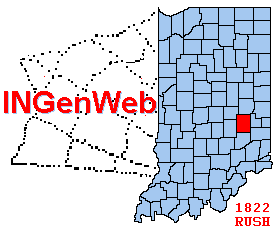

Rush County, Indiana
Genealogy
and History


Rush County, Indiana
Genealogy
and History
Centennial history of Rush County, Indiana Transcribed for the Rush Co. INGenWeb Project by Mark S. Mount
Authors: Anonymous
City of Publication: Indianapolis
Publisher: Historical Pub. Co.
Date: 1921

In this township, in section 25, along Ben Davis creek where "Arnold's Home" later came to be established, the Indians under the leadership of old Chief Mahoning (whom the whites when they came called Ben Davis) had their village long before white settlers began to invade the rich hunting grounds of the aboriginals hereabout. Even before the treaty which caused the Indians to be moved from their lands here several white men had settled in this section. They occupied themselves hunting and trapping and were on friendly relations with the Indians. Among these was Henry Sadorus, who had a cabin where the Indian trail crossed Big Flat Rock river, the point where John Smelser erected the mill which gave the name of Smelser's Mills to the point after 1822. Samuel Gruell put up a cabin on Ben Davis creek in the vicinity of the Indian village, now "Arnold's Home," and Weir Cassady settled on what later came to be known as the Joseph Hinchman farm, and there were no doubt other trappers and hunters as well as a few "squatters" who were awaiting their opportunity to claim title when the land was thrown open to sale, so that as early as 1819 there were found quite a number of white men on the ground. When the land sale was opened there was a rush for the lands west of the older counties of Fayette and Franklin and general settlement of the township was not long delayed. John Arnold, Raus Byrd Green, Thos. Sargeant and John Houghton bought land in this township on the first day of the land sale in October, 1820, and among those who came not long afterward are mentioned John Horlock, Amaziah Morgan, George and Michael Hittle, Samuel Danner, John McCillen, Wils Buzan, Sameul Newhouse, John Nash, John and Richard Blacklidge, George Nipp, Isaac Arnold, Jacob Virgil, Elisha Clark and Edward Swanson (afterward the murdered of Elisha Clark, as set out elsewhere), Peter Shafer, George and Matthew Zion, John Clifford, Samuel Durbon, John Morris, Obediah Seward, Philip and Richard Richee, Isaac Sparks, David Looney, Samuel Bussell, Lawrence Aspey, Conrad Hilligoss, James and John Hinchman, John Brown, Thomas, Henry and John Logan, John Garrison, Isaac and Abraham Fleener, David Low, Hiram Kindle and Robert Groves. The first white child born in the township was Louise, daugher of John Arnold, in June, 1822, and the first marriage was that of John Horlock and Mary, daughter if Isaac Arnold, in that same year. The Baptists organized a congregation as early as 1822 and erected a meeting house on Ben Davis creek. James Matthers and Clark Kitchen are mention as among the early school teachers. Shafer's sawmill on Ben Davis creek was an early convenience to the pioneers thereabout and Smelser's gristmill already has been mentioned. John Arnold opened a store on his farm, and this place of business was long a center of the community, for years local elections and musters being held there. On this farm lived Swanson, the only man ever hanged in Rush county, who was executed for the murder of Elisha Clark.
Union township is bounded on the north by Washington township and one section of Center township, east by Fayette county, south by Noble township and on the west;by Rush and Jackson townships. Glenwood in the southeastern part of the township (lying in sections 28 and 33 of this township and parly in Fayette county) and Mauzy or Griffin Station, are trading points on the C. I. & W. railroad and Gins Station in section 11 and Falmouth in the northeast corner (part lying in Union township, part in Washington township and part in the neighboring county of Fayette) are trading points on the Pennsylvania railroad. The township is well drained, the headwaters of Little Flat Rock river and its tributaries, Shankitank, Middle Fork, Shawnee, Plum and Turkey creeks draining the upper half and Ben Davis creek with its small tributaries draining the lower half of the township.
Glenwood - This is an incorporated village of about 300 population which, as above noted, lies partly in Rush county and partly in Fayette county. It was first known as Steele's, so called after its first postmaster, who was a pioneer tavern keeper at that point. In 1832 Dr. Jefferson Helm, Samuel Durbon and John Morris had a formal plat made of the town and gave it the name of Vienna, which some years later was changed to Glenwood and by this latter name the village since has been known. The first merchant at this point was Alfred Thompson and Henry and Thomas Thompson were the pioneer blacksmiths and wagon makers for the community which developed around the tavern and store. The first doctors were John Arnold and Jefferson Helm. Among the early business men were John Gatrell and Moses Wiley, wagon makers; Gideon Klink, saddler and harness maker; John Jack, merchant, Samuel Boden, carpenter; John Langley, who kept a store and was also a preacher, and G. Clawson, shoemaker. Among the early residents are mentioned Thomas Smiley, Joseph Clifford, Ward Williams, Thomas Ochiltree and Henry Cline. With the coming of the railroad Glenwood became stimulated with a new commercial spirit and a grain elevator afforded a convenient local market, while other lines of business also came in. The later arrival of the trolley line gave an additional impetus to the business life of the town. The Methodist Episcopalians and the United Presbyterians have churches at Glenwood and the Odd Fellows and Red Men have lodges.
Falmouth - This village also lies partly over the line of Fayette county and is also partly in Washington township, being in the extreme northeastern corner of Union township. It was "laid out" on the Fayette side of the line in 1822 and in the fall of 1867 D. M. Shawhan laid out an addition over the line in Rush county. The village has a population of about 200 and is a good trading point on the Pennsylvania railroad. The Methodist Episcopalians have a church there. Gings is a station on the Pennsylvania in section 11, a grain elevator, a store and a blacksmith shop composing the business interests of the place.